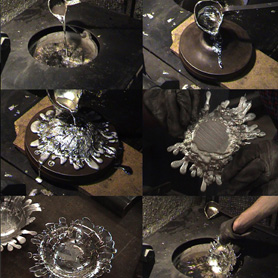Tim Parsons
Product Designer and Educator at School of the Art Institute of Chicago
Primary design concentration:
Product and Furniture Design
Most preferred tool for designing:
Brain, Hands, Sketchbook
1. How and why did you choose to become a designer?
I was good at drawing when I was young, and enjoyed it. It’s as simple and boring as that. I studied a general design course and thought I would become a graphic designer, but ended up being fascinated by objects and their potential for a richer and more lasting relationship with people. I went on to study product design at undergrad and grad levels.
2. Challenges you encounter as a designer and how do you deal with them?
I’m interested in thinking about new models of designing or adding something to a product area that has not been seen there before. It’s not lost on me that my teaching puts me in a privileged position in relation to earning a living. I do not have to make my design work pay. However, this means I feel a responsibility to conduct work that explores new territory, because the risk of failure does not have a great financial impact. Design schools have an important role in furthering the conceptual landscape. Of course, the flip side of this is that you occasionally do not get taken seriously by those in industry.
3. Your definition of an “elegant solution,” that is, good design?
Theorist Nigel Cross talks about “problem concepts” and “solution concepts” in his book Designerly Ways of Knowing and tells a great anecdote about Mies Van Der Rohe, who upon recounting the details of a client meeting said, [paraphrasing] “I showed him the building and first he was not very happy. But we smoked some cigars and drank some wine and eventually he liked it very much!” Mies had changed the client’s perception of the “problem concept” so it matched his solution. Hence, I feel an elegant solution is one where the result matches the intention of the project agreed by designer and client and does so without waste, ethical breach, etc. The sense that the proposal has an intuitive rightness about it is also important. I think a lot of Naoto Fukasawa’s work has this equation-like elegance to it. We size up the context and see that his solution fits it perfectly.
4. From skills to values, what makes a designer successful?
Intelligence. The successful designer, to me, is not the most famous or wealthy one, but the one who has brought the most interesting objects to the market without compromising their ideals. Many designers have skills. The vast swath of trash in the world’s landfill sites was designed by those who have plenty of skills, but are perhaps short on critical thinking, conceptual ability or just simply the courage to say “no”.
5. How do you stay motivated and grow personally and professionally as a designer?
For my sins, I am something of an eternal optimist. There are enough good reasons to design and write about design, that motivation is never the problem. Time is! Deciding where to focus one’s efforts is the problem. The main sources of stimulation for growth are my personal network of knowledgeable and provocative friends, who keep my ideas in check and enrich me with new knowledge and insights that lead to writing and design projects. Students and faculty at the school are another important source of intellectual stimulation, as is the design media and the other inspirations mentioned above. Before moving to the States, I had regular informal meetings with other designers, mimicking class critiques. We all felt that this mechanism was important but we missed it once we left education.
6. For those aspiring to become a designer, whatever the discipline, what is your advice?
Do it because you enjoy it, not to make money. Listen to your peers but don’t be afraid to ask questions of them, and be critical. Have high standards and stick to them!
7. What is your quest in design?
To produce things people will enjoy using, that work well and will have a long life where appropriate. To pose questions about object with objects. To pass on knowledge and experience to those who are interested. To be critically engaged in debates that help shape the way designers work, including myself. To act responsibly of course … I think that’s enough!
Previous: Jennifer Kinon & Bobby C. Martin Jr. | Next: Jussi Gamache

Support this solo initiative
What began as a collection of links has evolved into a comprehensive archive committed to creative culture—offering so far 395 interviews with under-the-radar Artists, Designers & Makers, in addition to 202 write-ups across events, books, movies, more. Free to explore. Free from ads. If you gain a level of motivation, knowledge, even delight, from Design Feast, please support on Patreon. Thanks for your consideration!
Wishing you continual success,
Nate Burgos, Content Creator & Publisher
Comments
There are no comments yet.
Leave Your Comment